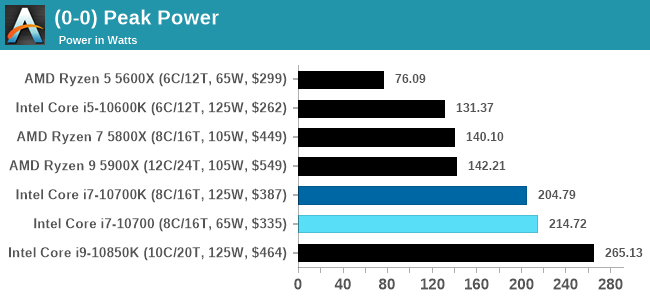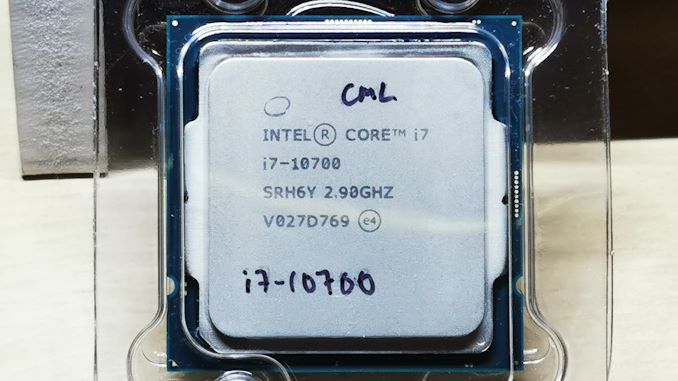Intel Core i7-10700 vs Core i7-10700K Review: Is 65W Comet Lake an Option?
by Dr. Ian Cutress on January 21, 2021 10:30 AM EST- Posted in
- CPUs
- Intel
- Core i7
- Z490
- 10th Gen Core
- Comet Lake
- i7-10700K
- i7-10700
Conclusion: TDP is Not Fit For Purpose
In years gone by, processors were sold with a single frequency and power rating. It was very quickly realized that if a processor could effectively go to sleep, using either lower voltage or lower frequency (or both) then a lot of idle power could be saved. Going the other way, processor designers realized that for temporary short bursts, a core could run at a higher frequency before it reached a thermal limit. Also, using a multi-core processor meant that either the power budget could be shared across all the cores, or it could be focused in one.
Both AMD and Intel have noticed this over time, and both companies have different attitudes on how they report numbers relating to ‘base frequency’ and related power as well as the bursty ‘turbo frequency’ and related power. Out of those four metrics, the only one Intel doesn’t provide is turbo power, because from their perspective it is system dependent.

Intel lets motherboard manufacturers determine how long a system can turbo for, and what that budget is. Intel encourages motherboard manufacturers to over-engineer the motherboards, not only for overclocking, but for non-overclockable CPUs to get the best performance for longer. This really messes up what the ‘default out-of-the-box performance’ should be if different motherboards give different values. The trend lately is that enthusiast motherboards enable an unlimited turbo budget, and the user building their system just has to deal with it.
This means that users who buy the Core i7-10700 in this review, despite the 65 W rating on the box, will have to cater for a system that will not only peak around 215 W, but sustain that 215 W during any extended high-performance load, such as rendering or compute. We really wished Intel put this 215 W value on the box to help end-users determine their cooling, as without sufficient guidance, users could be hitting thermal limits without even knowing why. At this point, 'Intel Recommended Values' for turbo time and budget mean nothing outside of Intel's own OEM partners building commercial systems.
Core i7-10700 vs Core i7-10700K Performance
In the review we highlighted that these two processors have a peak turbo frequency difference of 300 MHz and an all-core turbo frequency difference of 100 MHz. The fact that one is rated at 65 W and the other is rated at 125 W is inconsequential here, given that most end-user motherboards will simply enable turbo all the time. This means the performance in most of our tests between the two is practically identical, and consummate to a 100-300 MHz frequency difference.
In practically all of our tests, the Core i7-10700K is ahead by a super slim margin. At $387 for the 10700K compared to $335 for the 10700, the performance difference is not enough to warrant the $52 price difference between the two. Performance per dollar sides mostly with the Core i7-10700, although users getting the i7-10700K will likely look towards overclocking their processor to get the most out of it – that ultimately is what to pay for.
The other comparison point is with the Ryzen 5 5600X, which has two fewer cores but costs $299. In practically every test, the increased IPC of the Ryzen over Intel means that it sits identical with the Core i7 processors, AMD is cheaper on list price, and at a much lower power (AMD will peak around 76 W, compared to 215 W). AM4 motherboards are also abundant, while corresponding Intel motherboards are still expensive. The problem here however is that AMD is having such high demand for its product lines right now that finding one in stock might be difficult, and it probably won’t be at its recommended price.
Users in this price bracket have a tough choice – the more efficient AMD processor that might be in stock, compared to the Intel processor that will be in stock but more cooling will likely be required.











210 Comments
View All Comments
alexane - Sunday, January 24, 2021 - link
easy job online from home. I have received exactly $20845 last month from this home job. Join now this job and start making extra cash online. salary8 . comMilaEaston - Tuesday, January 26, 2021 - link
easy job online from home. I have received exactly $20845 last month from this home job. Join now this job and start making extra cash online. salary8 . com
flyingpants265 - Friday, January 22, 2021 - link
Right. I'm not even sure why this is an issue. TDP stands for "thermal design power", it's how much power the chip uses, it's not debatable.etal2 - Thursday, January 21, 2021 - link
What I'm missing from this review is a benchmark running under intels recommended settings.From what I've seen often people see the 65w rating and go on to combine the i7-10700 with cheap B460/H470 motherboards and basic coolers.
Duraz0rz - Thursday, January 21, 2021 - link
The problem here is that the turbo limit is not enforced by the chip, but by the mobo. So even cheap B460/H470 boards can set that limit to be higher than Intel's recommendations if they choose to. And no one that would be buying these boards will necessarily care to dig into the BIOS and set the limits themselves.Cygni - Thursday, January 21, 2021 - link
Yes, they would. There are lots of (admittedly niche) applications where outright sustained performance is less important that bursty performance in a limited thermal envelope, either due to space or ventilations issues. HTPCs, home servers, small industry applications, etcSo yeah, i agree with the OP, I would have liked to have seen performance numbers at the "suggested" 65w PL1.
Calin - Friday, January 22, 2021 - link
I totally agree with your comment, but what you ask for is a different article.Performance numbers in a strictly power limited environment - from Intel and AMD both (although Intel will be unfairly penalized by being three or so lithography generations behind).
Spunjji - Friday, January 22, 2021 - link
"unfairly penalized"The product you test is the product they have on sale - that's not unfair in the context of a test designed to represent a specific real-world requirement.
olde94 - Monday, January 25, 2021 - link
yeah i never heard anyone saing that amd was "unfairly penalized" in 2015. they could just "suck it up"Spunjji - Monday, January 25, 2021 - link
To be fair, some people did (GloFo's 28nm is terrible, I don't care about power, etc.) and I had no time for them either.